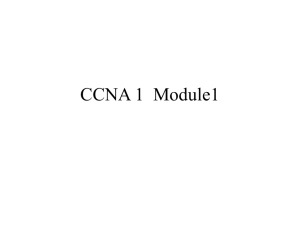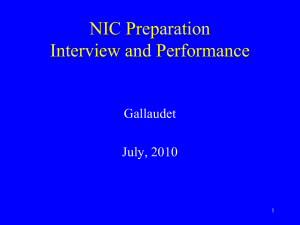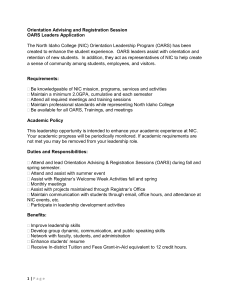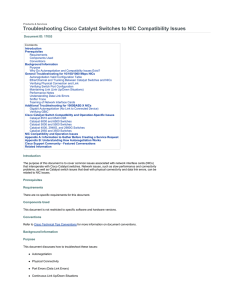IOFlow: A Software-Defined Storage Architecture
advertisement
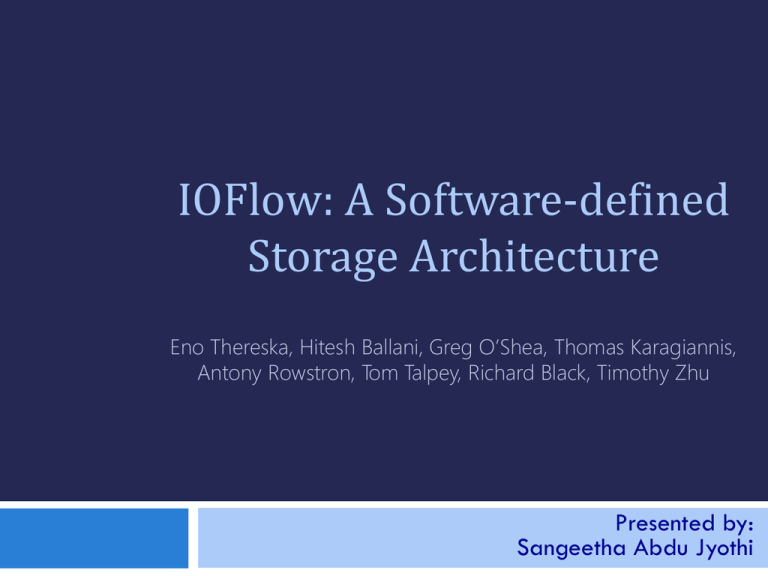
IOFlow: A Software-defined
Storage Architecture
Eno Thereska, Hitesh Ballani, Greg O’Shea, Thomas Karagiannis,
Antony Rowstron, Tom Talpey, Richard Black, Timothy Zhu
Presented by:
Sangeetha Abdu Jyothi
Virtualized storage
VM
VM
VM
VM
VM
VM
Virtual
Machine
Virtual
Machine
vDisk
vDisk
NIC
NIC
Switch
NIC
Switch
S-NIC
NIC
Switch
S-NIC
Motivation
Tenants require predictable behavior and
performance guarantees. But . . .
• IP traffic and storage traffic share network resources.
• IO path to storage comprises of multiple stages.
Difficult to provide performance guarantees for
storage IO flows.
Key requirements
IO differentiation along flow paths
Global visibility
Should not require application or VM changes
Key Components
IO differentiation along flow paths
- Data-plane queues
Global visibility
- Logically centralized controller
Should not require application or VM changes
- Applications not affected. Simple interface
between controller and applications
Other challenges
Block device
C: (/device/scsi1)
Flow name resolution
Distributed enforcement
Dynamic enforcement
Admission control
VM
VM
VM
Virtual
Machine
Block device
/device/ssd5
Virtual
Machine
vDisk
vDisk
NIC
NIC
Server Switch
and VHD
\\server1\123.vhd
S-NIC
Volume and file
H:\123.vhd
VM
VM
VM
NIC
Switch
NIC
Switch
S-NIC
IOFlow architecture
API for data-plane stages
Classification
Queue
servicing
Routing
Some policies
{VM p, Share X } Bandwidth B
{ p, X } Min Bandwidth B
{ p, X } Sanitize
{ p, X } High priority
{ [p,q,r] , [X ,Y]} Bandwidth B
Enforcing policy
{VM 4, Share X } Bandwidth B
SMBc:
1: getQueueInfo();
2: createQueueRule(<VM 4,//server X/*>, Q1)
3: createQueueRule(<*,*>, Q0)
4: configureQueueService(Q1, <B, 0, 1000>)
5: configureQueueService(Q0, <C-B, 0, 1000>)
Properties
Stages
• Soft-state queues
• If no match for a request, it is blocked and
controller is contacted.
• Configurable plumbing possible
• Rate-limiting with tokens – based on end-to-end
cost
• Allows splitting of IO requests for better
performance
• Location of policy implementation can be critical
for performance
Properties
Controller
• Discovery component generates stage level graph
• Flow name resolution to match stage specific
queuing rules
• Batched updates for non-critical applications
• Uses version numbers in configuration updates
Evaluation – Policy enforcement
Windows-based IO stack
Clients
10 hypervisor servers, 12 VMs each
4 tenants, 30 VMs/tenant, 3 VMs/tenant/server
1 storage server
SMB 3.0 file server protocol
3 types of backend: RAM, SSD, Disk
1 controller
1 s control interval
Evaluation – Policy enforcement
4 Hotmail tenants {Index, Data, Message, Log}
Tenant
Policy
Index
{VM 1 -30, X} -> Min 800 Mbps
Data
{VM 31 - 60, X} -> Min 800 Mbps
Message
{VM 61 -90, X} -> Min 2500 Mbps
Log
{VM 91 -120, X} -> Min 1500 Mbps
Evaluation
–
Policy
enforcement
Controller
notices red
tenant’s
performance
Tenants’ SLAs
enforced.
Intra-tenant Inter-tenant
work
work
conservation conservation
15
Evaluation – Performance & scalability
Worst case
reduction in
throughput:
RAM – 14%
SSD – 9%
Disk – 5%
Worst case
overhead in CPU
consumption at
hypervisors:
< 5%
Overhead (MB)
Evaluation – Performance & scalability
Summary
Software defined storage architecture
Data-plane queues facilitate fine-grained control
over storage IO performance
Compact and extremely useful API between
control plane and data plane
Control applications – performance control and
middlebox – successfully built with IOFlow API
Discussion
Integration with network traffic
Scalability
More applications and functionalities – latency
guarantees?
Failure at one stage blocks all the requests
using it


